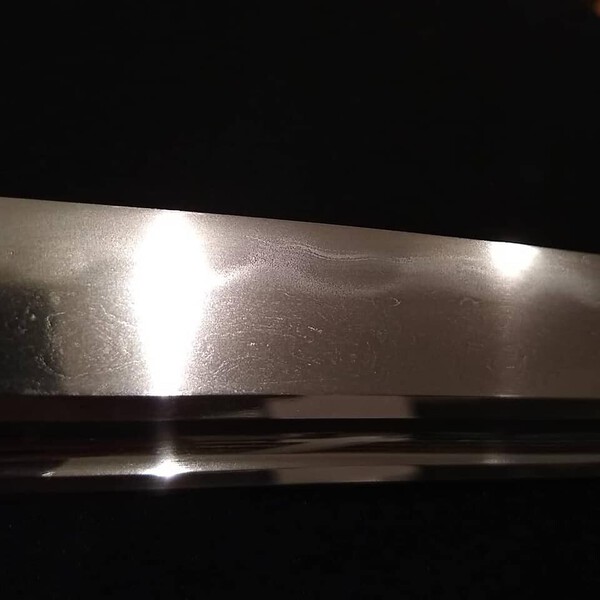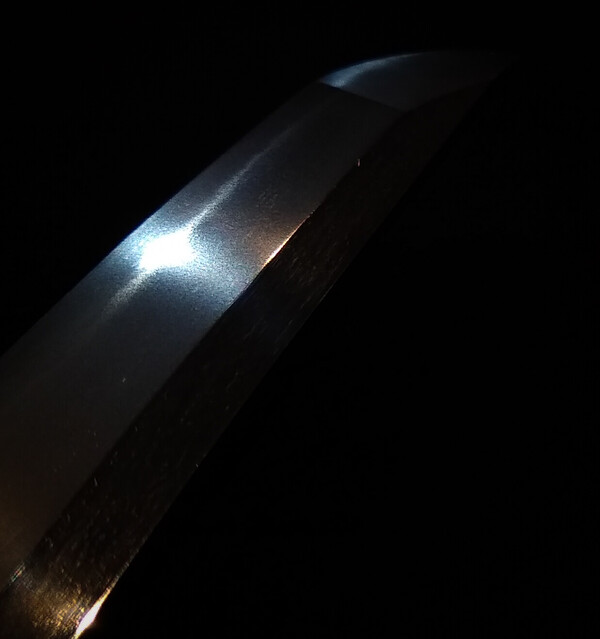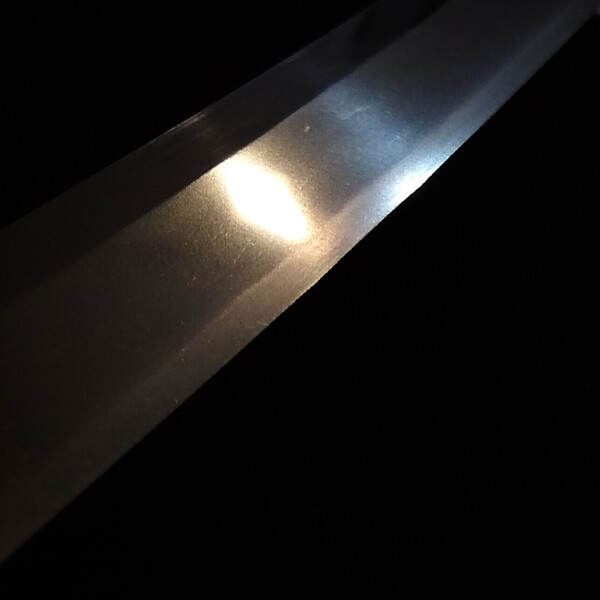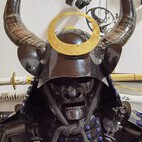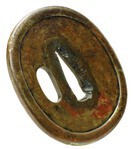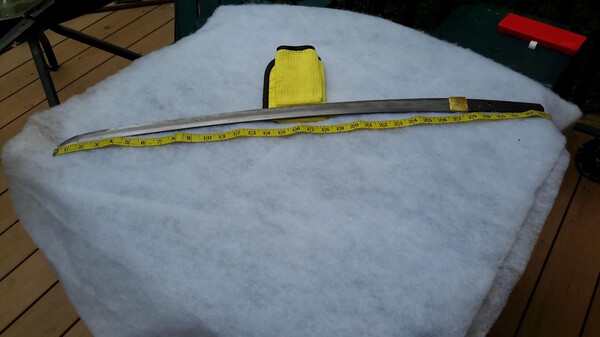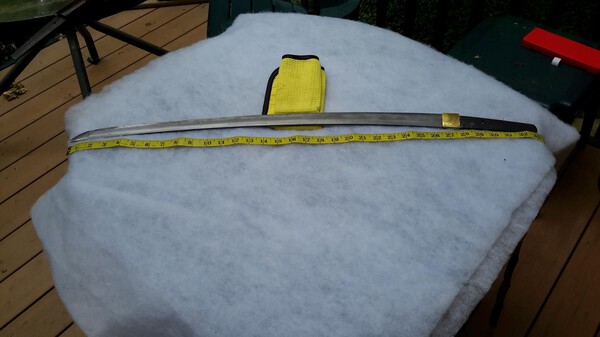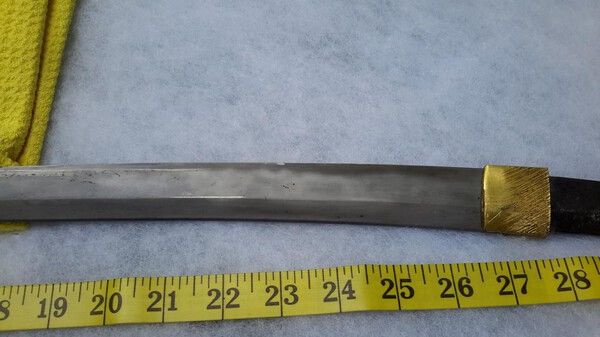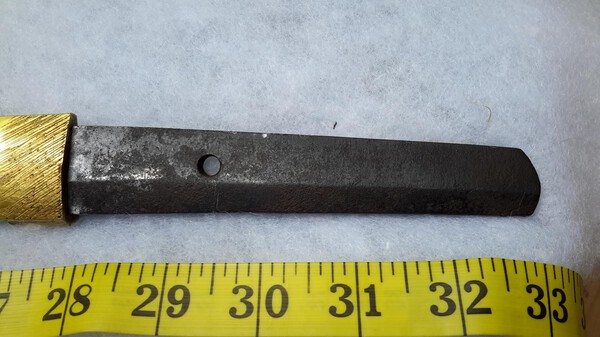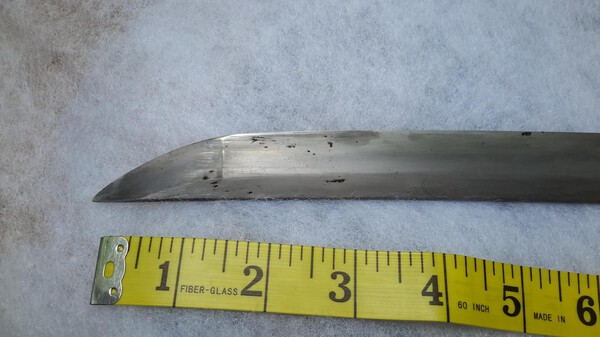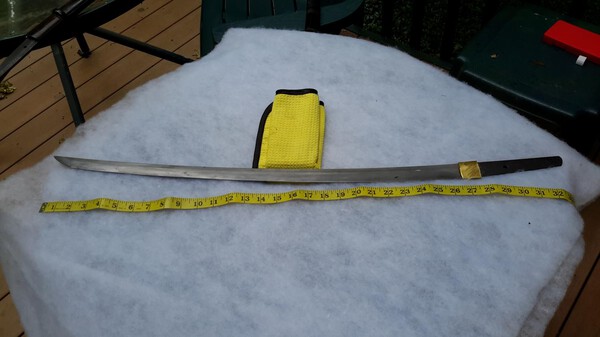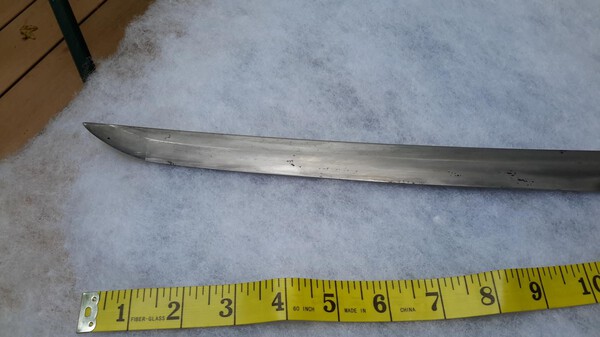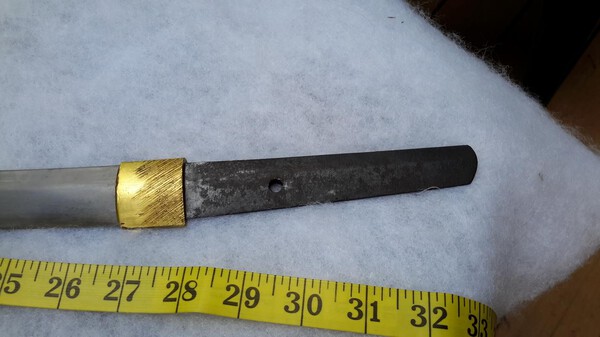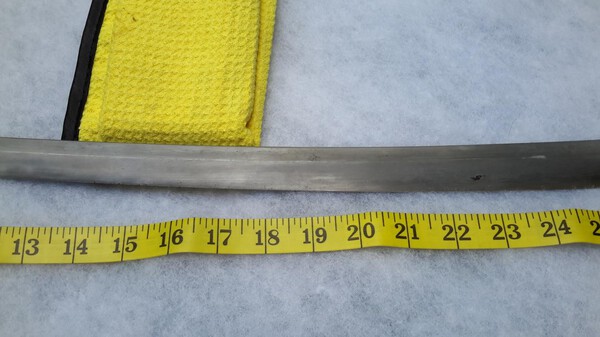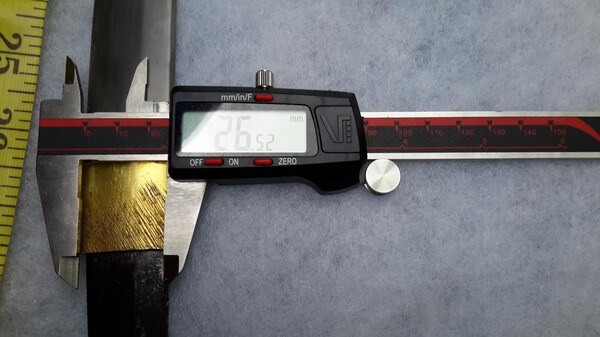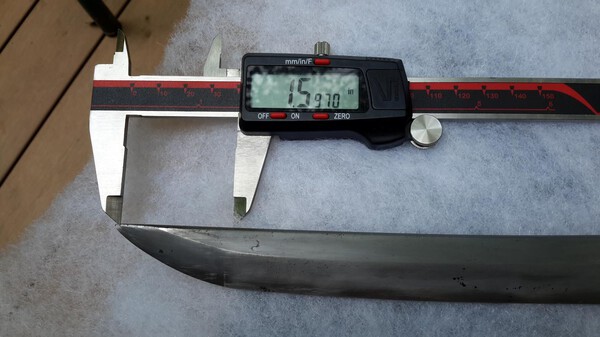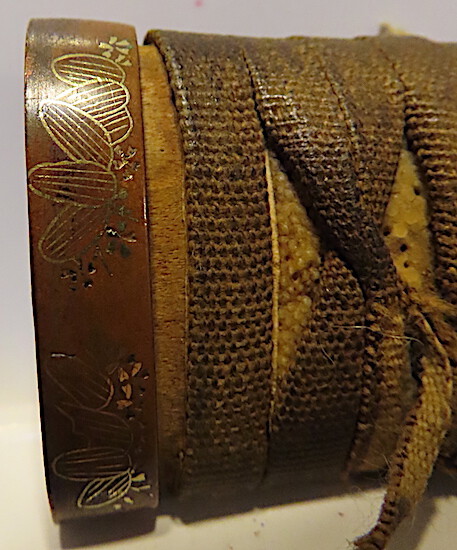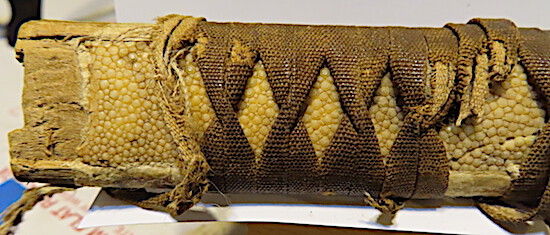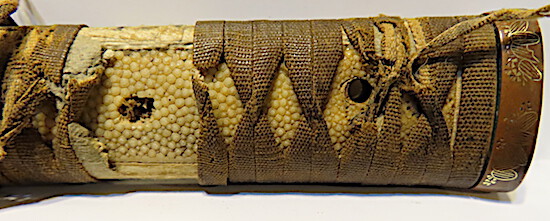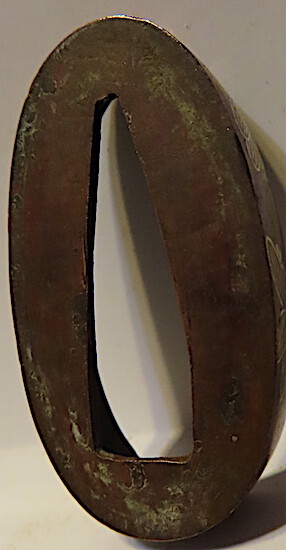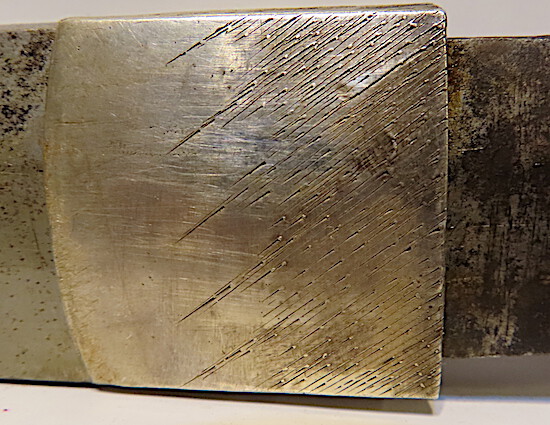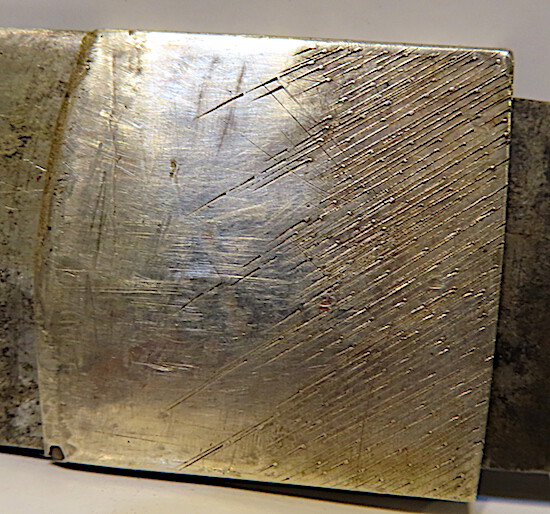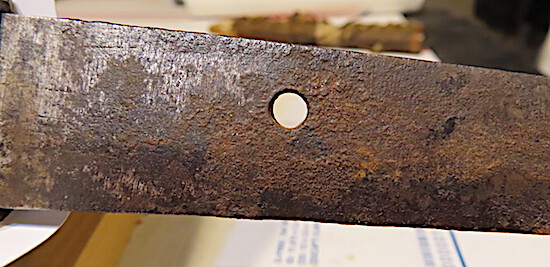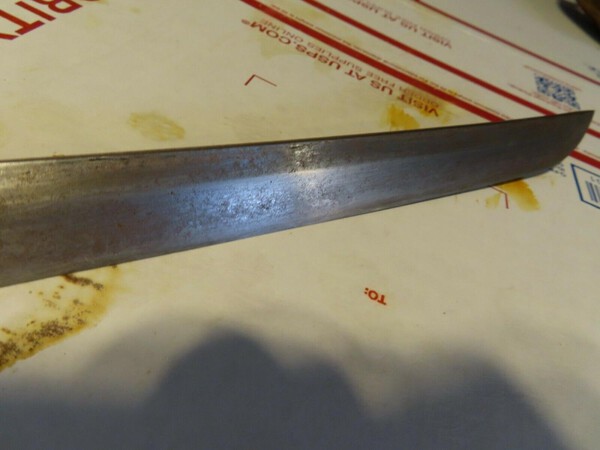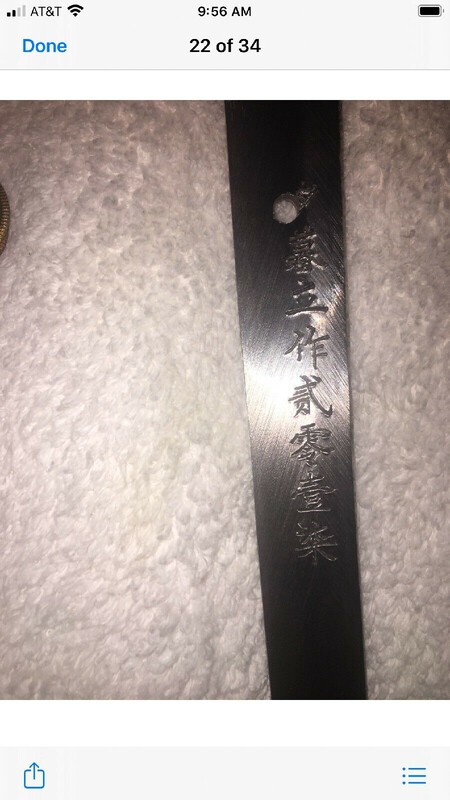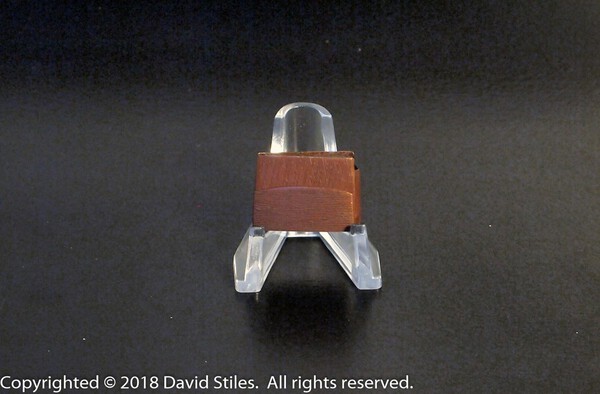Search the Community
Showing results for tags 'koto'.
-
Type: Wakizashi Ubu, Suriage or O-Suriage : Ubu Mei : (Mumei, Signature) : Bizen Ju (?Mitsu?) Papered or not and by whom? : Not Era/Age : Koto/Muromachi (~1500) Shirasaya, Koshirae or Bare Blade? : Koshirae + Shirasaya Nagasa: 49.7 cm. Sori: 1.5 cm. Moto-haba: 2.7 cm. Saki-haba: 1.7 cm. Moto-gasane: 0.7 cm. Saki-gasane: 0.5 cm. Flaws : Old hadaware fix (please check pictures) Sword Location : Poland EU Will ship to : Anywhere Payment Methods Accepted : Bank2bank wire-transfer (USD) Price and Currency : 2650$ + shipment costs. Other Info and Full Description : Hi, I'm looking to sell my Koto Bizen Osafune Wakizashi. Decent polish and very good (IMHO) overall condition. It comes with beautiful Koshirae (renovated, Fuchi/Kashira/Menuki/Tsuba/Kojiri are from early Edo period). If you are interested, please ask and I will do my best to answer. I can also post additional pictures or videos if needed. My asking price is equal to what I have paid, no earnings here.
-
I am listing my Juyo Token blade for sale with the consent of my instructor, Tatsuhiko Konno-sensei. This is a fine example of a Taima blade (mumei) dating from the late Kamakura period. This blade was awarded Juyo Token at the 67th NBTHK evaluation. The blade comes with a shirasaya, oshigata, and a double-layer, gold-plated habaki. Type (Tachi, Katana, Wakizashi, Tanto, Naginata, Other) : Katana Ubu, Suriage or O-Suriage : Suriage Mei : (Mumei, Signature) : Mumei Papered or not and by whom? : Juyo Token, 67th NBTHK Era/Age : Late Kamakura Period Shirasaya, Koshirae or Bare Blade? : Shirasaya Weight: 610 g Nagasa/Blade Length : 61.9 cm Sori : 1.3 cm Mekugi-ana: 3 Width at base: 3.0 cm Width at tip: 2.2 cm Thickness: 0.6 cm Hamon Type : Suguha Jihada : Mokume-hada Other Hataraki Visible : Nioi-guchi Flaws : N/A Other Info and Full Description : The blade was judged as belonging to the Taima school. The Taima school is one of the 5 Yamato schools, along with Hosho, Senjuin, Shikkake, and Tegai. Yamato den swords are quite uncommon, and those of the Taima are especially uncommon. Despite (or perhaps partially due to) their rarity, Taima blades often trickle up to Juyo status. This blade has a large suriage, but the fundamental characteristics of the blade are clear to see. Namely, the polish brings out the fantastic Taima school mokume hada - on a personal note, I have studied many blades under my instructor, and have never seen one with such beautiful and apparent hada as this. The hamon of the blade is of course suguha, but has a deep nioi-guchi. I like to think of suguha hamon as a ZNKR seitei kata - though standard in outward appearance between many blades, the execution truly distinguishes masters. I hope this blade may become a fine part of your collection. Sword Location : Seattle, WA Will ship to : US (need to research for overseas, my first time!) Payment Methods Accepted : Bank Wire (open to discussion) Price and Currency : $22,000 USD This is a price I will have to consult with my instructor on, but am open to discussion. Unfortunately, given the current political climate in the US, there may be a hefty surcharge on any blades coming in the future.
-
-
Wakizashi - Mumei attributed to Shitahara Length: 54.3 cm (1.79 Shaku) Sori: 1.7 cm Motohaba: 2.9 cm Sakihaba: 2.0 cm Moto-kasane: 7.5 mm Description: Shitahara from the late Muromachi period. The blade is in immaculate condition without any hint of reshaping. It is Ubu and unsigned. Jigane is itame mixed with mokume, ji-nie and chikei present. Hamon is wide suguha style gunome with slight notare. Activities in the hamon includes hotsure, kuichigai-ba, ko-ashi, yō, kinsuji, and sunagashi. Additional photos: https://1drv.ms/f/c/...azhk4Ne9b7A?e=eNUqqc Asking for $950 USD or best offer + free shipping between USA and Canada. Will have to ship with private couriers due to Canada Post on strike (e.g. FedEx, UPS, Purolator).
-
ALL Japanese Swords on StCroixBlades.com site ON SALE starting now! https://stcroixblade...hop/Japanese-swords/ Additional Japanese Swords ON SALE in St. Croix Blades' eBay Store! (you don't need to be an eBay member to purchase--just Contact St. Croix Blades on our site, or by emailing info@stcroixblades.com, or calling/texting 715-557-1688). https://www.ebay.com...ificSeller=1&_sop=16 If you have any questions, let me know. Sincerely, Matthew Brice St. Croix Blades
-
Hi everyone, while browsing for swords, as one does, I stumbled across this piece that has in its description celebratory tanto from Muromachi period called "iwaizashi" I would like to ask studied people from this forum that would be able to explain if there is any truth to the statement ? The description states that presented tanto was made as a gift for celebratory occasions and is engraved with chiyotsuru inscription. I will add the full description with pictures below This tanto is a celebratory dagger made in the Muromachi period and called "iwaizashi," and is a rare piece that is rarely found on the market. It was made as a gift for celebratory occasions and was very auspicious, and this piece is engraved with a chiyotsuru inscription. Chiyotsuru is a school of swordsmiths that flourished from the Nanbokucho period to the Muromachi period (1336-1573), also known as the Echizen Rai school, because it was founded by Chiyotsuru Kuniyasu, a member of the Rai Kuniyasu school, who migrated to the Echizen region. Since the crane (tsuru) has been a symbol of good fortune in Japan since ancient times, it is believed that they asked Chiyotsuru, which means crane that lives a thousand years, to create a celebratory dagger. As in any other collecting field buy the thing not the story, and I really like tha blade itself but if the story proves somewhat true it would be a strong contender for my next purchase. So I share it with all of you good people here, the people more studied than my self. Have a great day everyone.
- 7 replies
-
- 1
-

-
- koto
- translation
-
(and 1 more)
Tagged with:
-
Hello I’m inquiring about the Japanese term for the hamon with such utsuri and the schools that introduced and made it. thank you j
-
While studying Muramasa blades, I recently came across a blade on a Japanese sword auction site (no, not Yahoo Auctions, Aucfree, or anything similar) with JTK paperwork attributing the sword to later generation Muramasa with an age around the Tensho era of Japan. I'm familiar with Tensho Muramasa (sandai), but I am unfamiliar with the reliability of the JTK. Can anyone give any insight on the validity of the blade? THe blade does appear to have tanago-jiri nakago, alongside an o-notare nioiguchi, but I lack knowledge on Muramasa's horimono, alongside the difference between Tensho Muramasa and Sengo Masashige. Any help would be much appreciated! Sincerely, Zoglet PS- If substantiated by the details, please don't snatch up the sword. Finders keepers, and this looks like a stunning blade to me (my partner happens to also love the blade's appearance)
-
Recently I got my hands on a koto sword in shirasaya with sayagaki from Hon'ami Nishu (recognized the kao marking), but I've only been able to translate bits and pieces of the sayagaki. I would deeply appreciate any assistance on translating the sword's sayagaki, sending what I could not translate myself. Thank you so much to everyone on here! Sincerely, Zoglet
-
Hello gents, I offer a beautiful Naginata Naoshi Wakizashi, that I currently received back from the NTHK shinsa in Chicago last month. The blade is mumei. The Naginata Naoshi was attributed to Boshu Nio Kiyozane, who worked in the first half of the 15th century around 1440. Here are the measurements: Nagasa: 41cm Nakago Nagasa: 12,8cm Motohaba: 2,7cm Sakihaba: 2,5cm Sori: 1,2cm Motokasane: 0,3cm The workmanship is influenced by Yamato and Soshu den. The sword was originally made as a Naginata, but later shortened to its current length, so it became a Naginata Naoshi with a shobuzukuri construction. The blade has a itame hada mixed with a burl mokume hada, which becomes a straighter Yamato style masame hada through the edge. The hamon is made in suguha notare with a deep nioi guchi of prevalent nie. This complex hamon ends in a beautiful yakizume boshi. Additional activities inside the wakizashi are yabashiri, ji nie, nijuba and inazuma. The overall condition of this sword is excellent to near mint. The old Japanese polish is quite good. There is a larger ware on one side of the blade, but it is nether fatal nor disturbing. This blade comes with a high quality edo period koshirae. The worksheet of the NTHK shinsa is included in this sale. As soon as I receive the kanteisho from Japan, I will send it to the new owner. The wakizashi stays currently with me in Germany and can be shipped worldwide with DHL premium international. My asking price is 2900€ or best offer. Payment should be done via paypal friends and family, or with a transaction directly to my bank account.
-
I was doing a few different things around the house this afternoon including the cleaning my Japanese swords today before the seasonal change early next week and the coming of Summer. Here are some better photos of the Koto Kanemoto Katana that I received back from the polisher in February (previous topics are in this discussion group). I am no longer a Japanese sword dealer but can still take great photos. Here are a few resized for upload to NMB. Enjoy and feel free to discuss it politely.
-
Type (Tachi, Katana, Wakizashi, Tanto, Naginata, Other) : Katana Ubu, Suriage or O-Suriage : Ubu or close to ubu Mei : (Mumei, Signature) : Taira Nagamori (平長盛) Papered or not and by whom? : NBTHK Hozon Era/Age : Muromachi Period Shirasaya, Koshirae or Bare Blade? : Shirasaya & koshirae Nagasa/Blade Length : 71cm / 27.95 inches Sori : 1.7cm / 0.6 in Motohaba : 2.69cm / 1.05 in Kasane : 0.8cm / 0.31 in Hamon Type : based on suguha in nie deki, plentiful ashi, hakikake boshi Jihada : itame-nagare mixed with masame and o-hada Other Hataraki Visible : ji-nie Flaws : conspicuous Masame-ware, conspicuous rough hada and o-hada, small ware near kissaki on ura side Sword Location : Georgia, USA Will ship to : Anywhere. Buyer assumes full responsibility for getting the sword through import customs and/or any legal issues with receiving a sword in the receiving county Payment Methods Accepted : Zelle, Paypal Price and Currency : $3250 USD OBO + calculated shipping Other Info and Full Description : A long kanmuri-otoshi or nagamaki-naoshi-zukuri katana signed Taira Nagamori. In shirasaya with koshirae. NBTHK Hozon. I've done my best to take useful photographs but I am happy to answer questions or take additional photos. I will be listing this on eBay at some point, but it's offered for less here minus the fees.
-
As promised the second addition, this one for the Bizen crowd. This sword is o-suriage mumei with gonome choji-ba hamon, ko-nie, and utsuri. The better photos are again courtesy of @Ray Singer (that may be a trend with these) with some of my own thrown in... I know I need a darker background. Happy to provide any photos of specific areas if my skills allow. nagasa 69.9cm moto-haba 3.2cm kasane 6mm There is varying opinion on attribution: The NTHK attributed the blade to Hidekage, Eikyō era; there is a remnant of an old kinpunmei (see photo) that might be mitsu 光; and a previous owner was told it could be Nanbokucho Omiya. Attributions all in the same general style but vary from Nanbokucho to early Muromachi. In hand it has a lot of heft to it. I do plan to send to NBTHK shinsa once global shipping is more reliable and will update the thread then. The blade has a lot of heft and a lot of activity to see in hand that I am not good at describing quite yet. This was a forum purchase so some of you may have seen glimpses of it before. (The black line in the boshi is a relfection, not a ware)
-
Hello. This is my first post here, so I thought I would start by showing off my most recent acquisition. This is a small ken. It is double edged with a suguha hamon, and is unfortunately mumei. The blade is quite tired, as you will see in the following images, though does still retain quite a nice polish. The habaki is copper, wrapped in silver, and may not be original. The entire piece is in shirasaya, which does appear to be rather old as well. Judging by the appearance of the blade and nakago, as well as some consultation with an expert, this small ken may be from the Nanboku-chō to early Muromachi Period, though I am not certain. What are your thoughts? I may end up putting it up for trade eventually. Imgur link, due to the files being too large: https://imgur.io/a/PeNGViN
-
I just wanted to start this new topic about the polishing of my Kanemoto Katana, which has been in the works for over a year. I just received an update from the polisher. The dark spots in the ji and ha have been cleaned, as well as the rust specks on the mune (see before restoration photo below). He is now working with the uchigomori stone for those areas, he will then move on to shiage. At this point I am so far down the "rabbit hole" I will disclose who the professional Japanese sword polisher is. It is Woody Hall who is based out of Las Vegas. Once I get the sword in hand, I will post photos to this topic on NMB. Have a wonderful week everyone.
-
First off, I hope those of you at the Chicago show are having a great time on day 1. Hope to make it to one once I am back State-side. For those of us stuck at home, as promised the last in the series and it is for the Soshu crowd -- This sword is an osuriage wakizashi which appears to be a Nanbokucho-period naginata/nagamaki-naoshi. With ato-bori bo-hi and the kaeri looks intact to me. Although a commenter did think it was rather a shobu zukuri tanto or ko-wakazashi. It has itame jihada with nie arcing out of the hamon becoming chikei in the ji. The hamon is midare, with some gonome-midare. Like the Bizen in #2 I do plan to send this to NBTHK shinsa once global shipping is more reliable and will update the thread then. This was also featured on the forum for purchase so some of you may have seen glimpses of it before (hint hint to those looking for a first piece, some great deals here on the NMB with some patience ). Again credit to @Ray Singer for the better photos. to everyone for taking a look, I hope the series provided some examples of various smiths and traditions until we can all get out and view more swords comfortably again. Nagasa: 41.1cm moto-haba: 31mm 7mm thick at the shinogi The sword has two old attributions: an early 1962 green paper to Naoe Shizu and an old sayagaki from Honami Koson to Sa Kunihiro. (Those are lights reflected int he boshi along the edge...)
-
Hello. Can anyone read grass writing? I could really use your help. Thank you! —Matt www.StCroixBlades.com
- 19 replies
-
- koto
- translation
-
(and 1 more)
Tagged with:
-
Hello all, acquired a few pieces over the past year's mix of COVID lock-downs and while eagerly waiting for the latest to arrive thought I would start a few threads to share the blades with fellow members and provide some more searchable examples of these smiths for the NMB. Also maybe start some discussion if anyone sees anything interesting. The first is a papered NBTHK TH to Ko-Mihara with a sayagaki from Tanobe Sensei. Photos are courtesy of @Ray Singer and will get an in-hand update/photos once it arrives hopefully this week… delayed due to an issue at the DPO transit point . Without a full translation yet but looks like Tanobe-sensei commented that it a representative example of the sword, dates to Nanbokucho jidai, is osuriage mumei, and yuhin (exceptional work). I had been on the lookout for a blade in this style with some helpful advice and comments on other pieces from @paulb . nagasa: 66.3cm moto-haba: 28mm saki-haba: 18mm kasane: 6.5mm The next two pieces to be posted await post-COVID shinsa but have other attributions that might spur some debate.
-
Afternoon/morning gentlemen! Its been a while since I've posted a blade of mine here but I just recently bought this from Eric from his eBay store for a modest sum. I rather like the blade despite the few flaws it has. I will let the pictures do the talking since Eric was so kind as to allow me to keep/use them here for discussion. Eric believes it is Sue-Bizen and dates to around 1530. Utsuri is present. Here are the measurements and specifics, as per Eric: Blade: Nagasa: 25" Nakago : 5-5/8" Total blade length : 30-5/8" Blade thickness at the habaki notch : 7.13 mm Width at the habaki : 1-3/16" Width at yokote level : 13/16" Sori / curve : 7/16" Point / Kissaki : 1-1/4" Hamon: A beautiful very attractive well controlled Choji-ba on both sides. Strong long point/kissaki & there is boshi turn-back on both sides. Hada : Itame mix with beautiful activities within Mounts: Blade rests in its original WW2 gunto mounts circa 1940 in fair condition Showing some wear & tear from age & WW2 use. A Family Mon on Kashira & wooden scabbard with no leather cover. Pieced Tsuba + 4 seppa's Original old silver foil habaki Solid handle but showing some fraying & losses on the brown-silk wrap Good solid scabbard & the lock mechanism works fine. My only ask is: what do you all think of it? I think I did pretty well. I am happy with it and there is a lot to study.
-
Hi there, Its me again. This time I wanted to post my 2 katana that i own. both of them seem interesting, atleast to me. The one in koshirae couldnt be attributed to a smith(in the hozon certificate), the only information i have about it is that its mumei, sue bizen school and from the bunmei era (1469 - 1487). it also has a bit of damage at a specific spot (shown in the pictures). If anyone is able to find out more info about it, please tell me. The one in the Shirasaya is allegedly a Kaneharu Gen.3 piece (Kanbun 1661 - 1673). it isnt NBTHK papered but i have Japanese registration papers and an assessment document of an expert from germany. what i find interesting about it is that its length is 2 shaku down to the millimetre. so from the length alone it could be both a katana or a wakizashi. Now i first gotta save some money till i can make my next purchase.
-
Hey everyone, I have another blade here to share. It appears to have an o-kissaki. I believe the patina on the nakago points to it being koto in age. Here are the measurements: Nagasa: 27 inches or 692mm (the measuring tape was not really cooperating and stretching in the heat!) Sori: .8525 inches or 21.65mm Width at Habaki: 1.04 inches or 26.52mm Kissaki Length: 1.6 inches or 40.64mm Overall Length: 33 inches or 838.2mm The blades overall hamon pattern is obscured but it appears to a form of notare but I cannot honestly say to what degree or if it is simply a more complex pattern hidden by the lack of polish. The blade seems to be healthy enough to receive a new polish and I do not detect any fatal flaws; the yokote is intact as well. I think this blade is on its first polish but someone may have taken a buffing wheel or something similar to it as the metal has a 'slicked' appearance to it. I am also unable to remove the habaki as it is firmly rooted on and appears to already have taken a beating from a previous owner attempting to remove it. Opinions of all kinds are welcome. I bow to the knowledge of my betters! Thanks guys!
-
Hey guys, I know things have been a bit slow around here with people selling/showing/talking about blades so I thought I'd post another one of my blades. I think this one is either koto or shinto and appears to have Sukesada-like qualities to it. I am just looking for general opinions. I think the blade's overall condition is poor with the polish being non-existent but the blade itself is very healthy so likely only on its first or second polish. It is mumei but I think would be a good candidate to be restored. And I've heard people say you can remove active rust with antler, but what kind and quality of antler? I also have a rather worn tsuba that I've no proper knowledge of; it came with it and fits rather well.. I will post that in tosogu later! Opinions are appreciated!
-
Hey all! I am in the process of obtaining two tachi blades made by the same smith purportedly. Can anyone give me a translation of the following kanji found on one of the blades? Thanks and have a Merry Christmas! ~Chris
-
Here is quick preview for my mid month update of Tsuba Otaku website (www.tsubaotaku.com) of a kotō tantō I am going to be adding to the homepage. The length of the cutting edge is 25.4 cm. It is unsigned but was attributed by Honami Tsunemasa to Echizen Rai Munemitsu who worked in Ōei Era ( circa 1392-1428 CE) in Echizen Province but came from Yamato Province. The tip has has been reshaped and the sword shorten due to serious combat damage via a method called satsu-age. This process was not extreme enough for the tanto to lose its boshi or to have the nakago shorted in anyway as it is still ubu. The copper two piece habaki is very nice. Here is a photo of it as well. The ji-hada is itame with a mixture of a running masame visible in a few places. Polite discussion is always welcome.

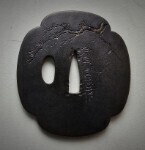
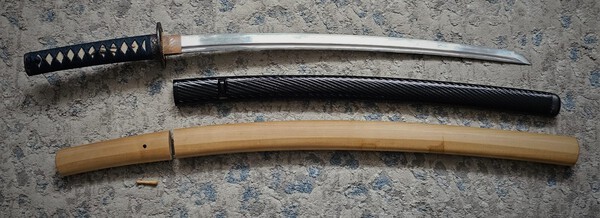













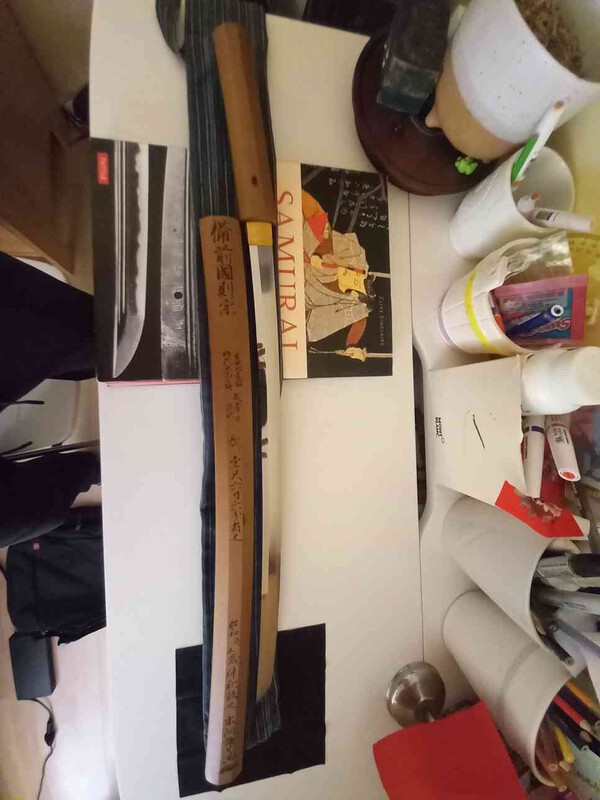


















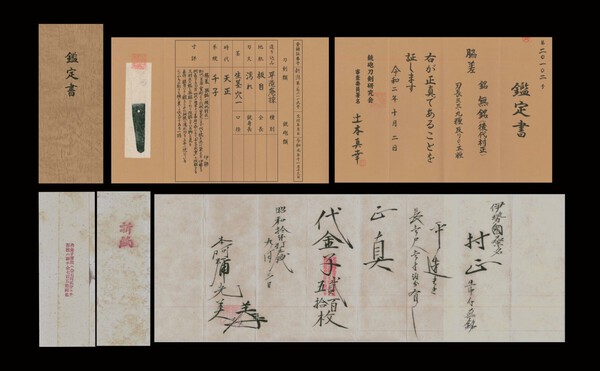
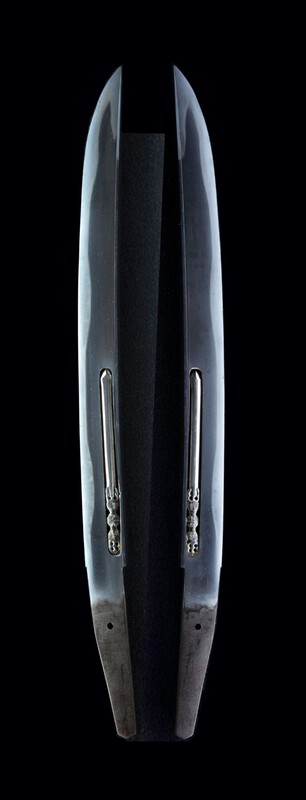





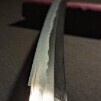
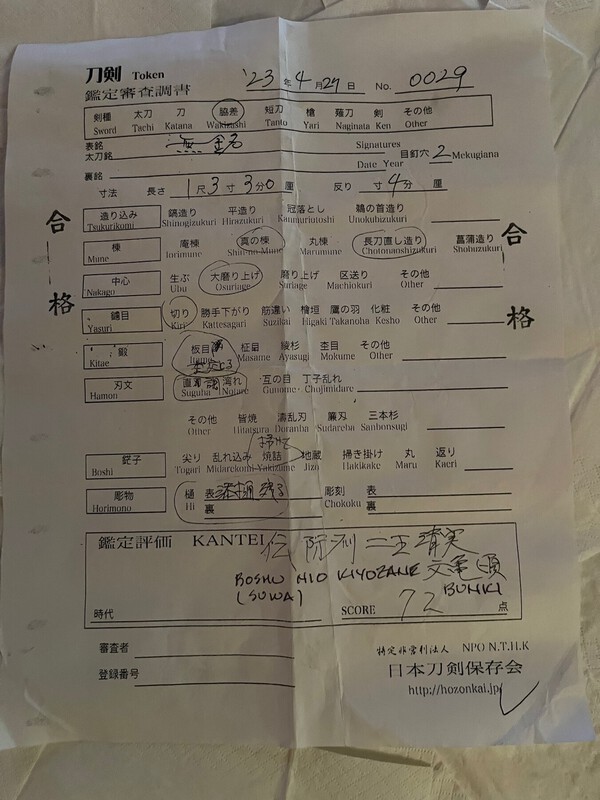
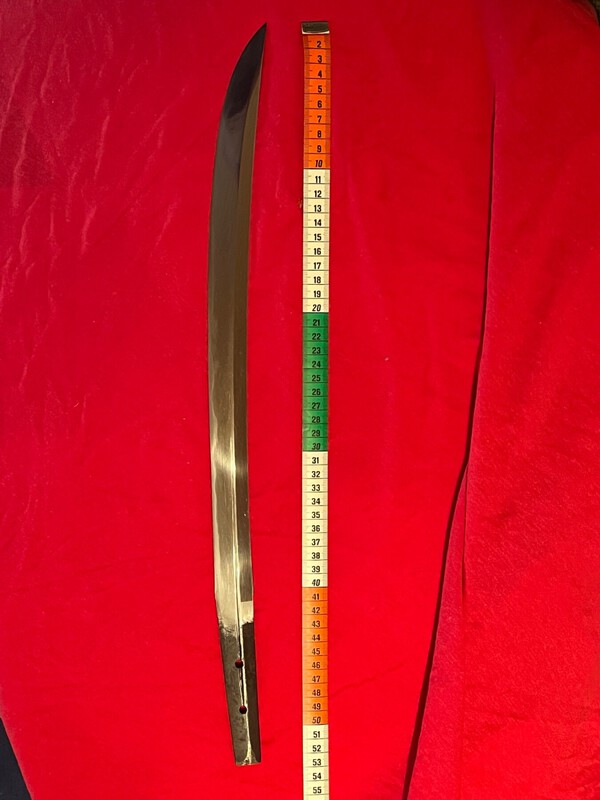

.thumb.jpg.0cf07a5b6d1165ae56aa7ab3dc23b16e.jpg)
.thumb.jpg.8d1dcf5c1ddab2387d7fbb54c4971a45.jpg)


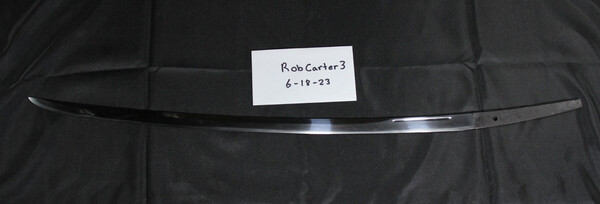
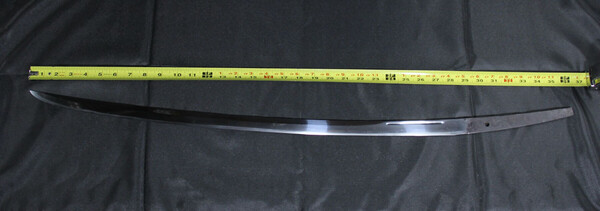


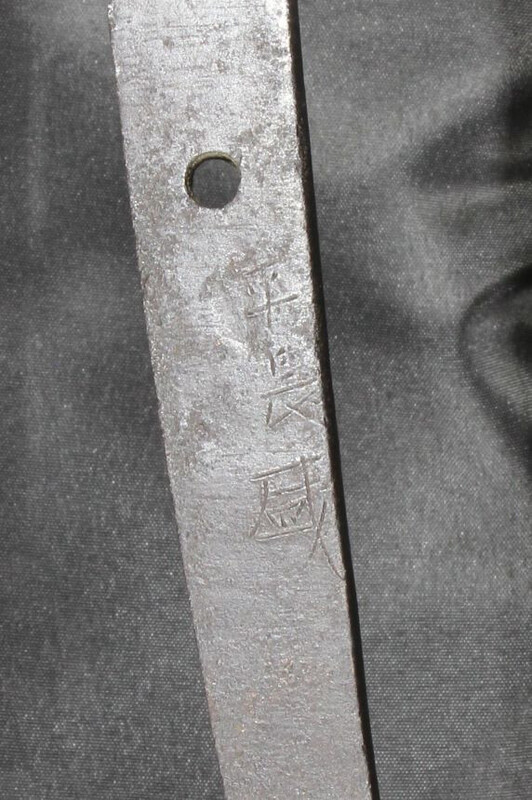
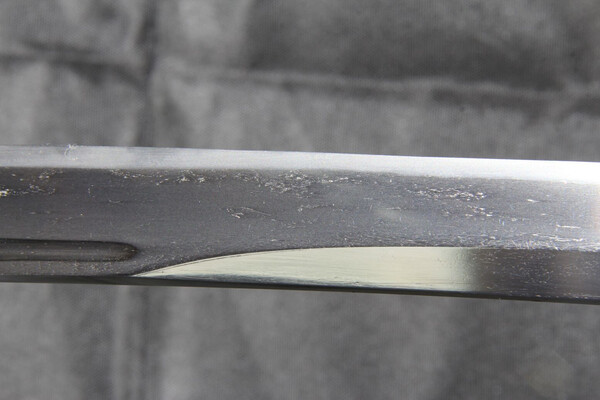
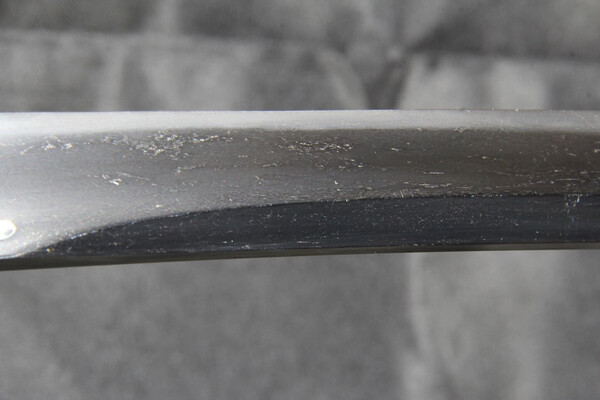
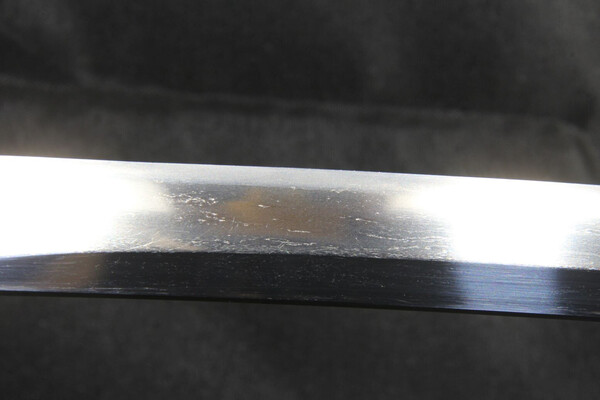
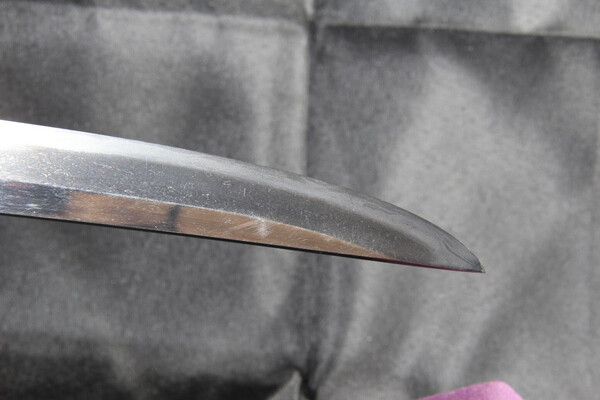
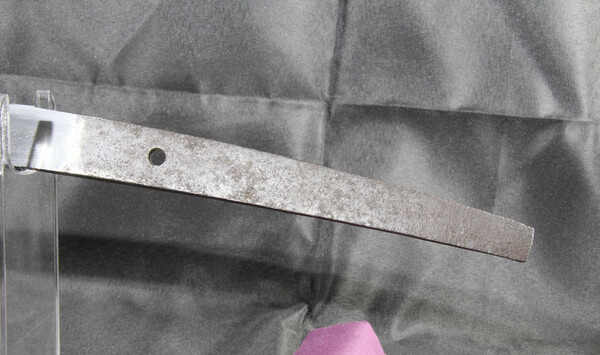
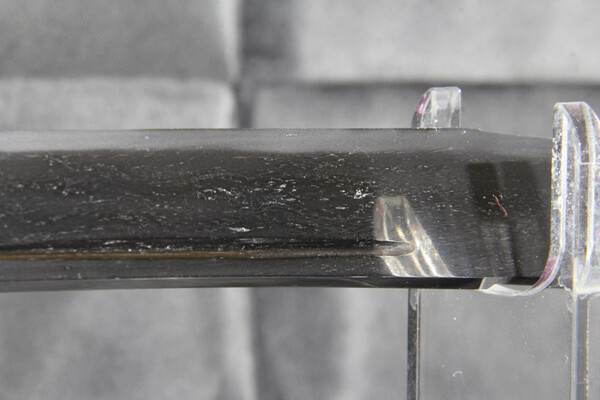
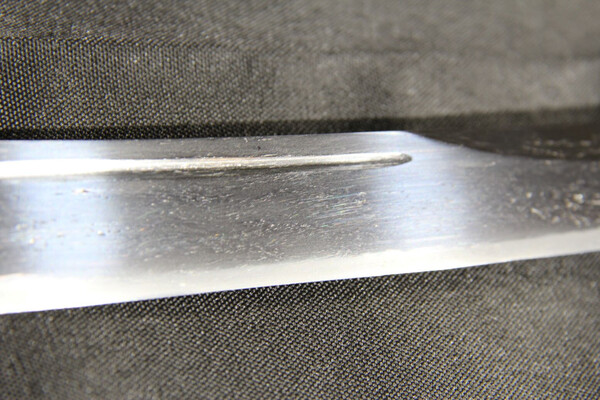
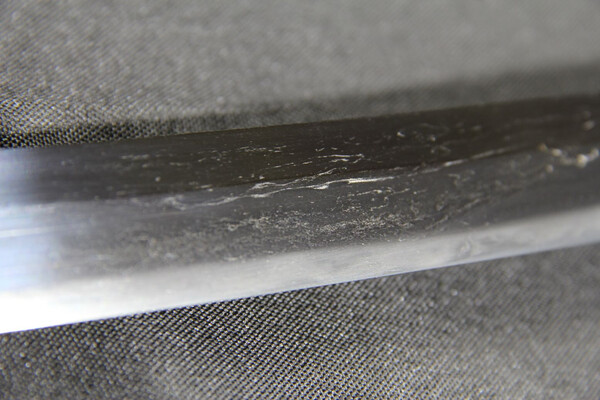


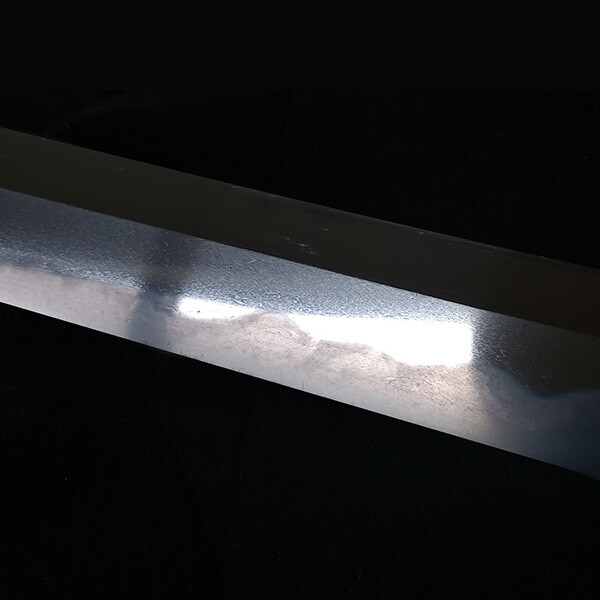



.thumb.jpg.1aa821fb2677d81d007730ce766a475e.jpg)
.thumb.jpg.3d352ef56fa160e6847cd2f06feb05e5.jpg)


